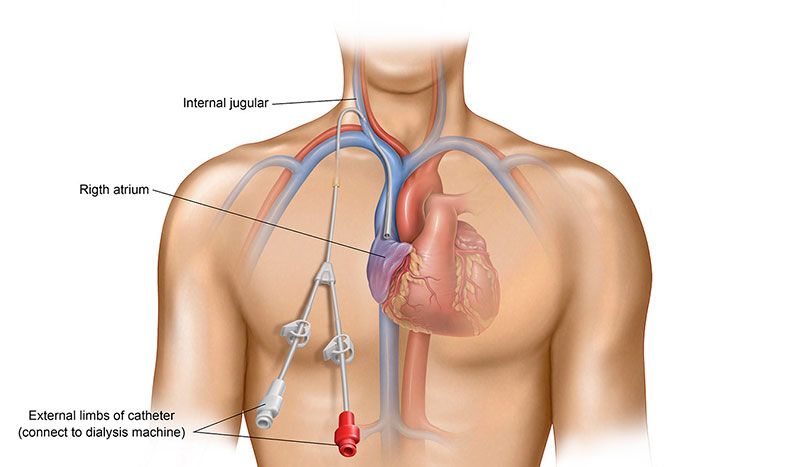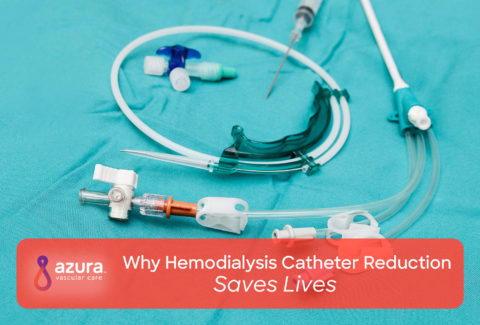
Have you recently been told by your doctor that you need a central venous catheter (CVC) for your dialysis access? If so, it’s important you understand as much as possible about this type of access.
There are three basic options or types of dialysis access.
- Central venous catheter (CVC)
- Arteriovenous fistula (AV fistula)
- Arteriovenous graft (AV graft)
A central venous catheter (CVC) access is most often used on a temporary basis. It’s not the best long-term option for several reasons, which we’ll discuss in more detail later. But first you need to understand exactly what a CVC is and who it works best for.
What Is a Central Venous Catheter?
A central venous catheter is a long, plastic, y-shaped, flexible tube. During an outpatient procedure, a physician who specializes in vascular access makes a small incision in the skin over the selected vein located in the neck, upper chest, or groin. Then, using a guide wire the catheter is inserted into the vein.

The Y end of the CVC remains outside your body. The two flexible tubes at the Y end of your CVC are connected to the bloodlines during dialysis, allowing for the transfer of blood to and from your body to the dialysis machine and back. A protective cap is placed at the end of the Y-shaped tubes when they are not being used.
Who Can Get a Central Venous Catheter?
If your kidney function has deteriorated to the point where you need immediate dialysis, a temporary CVC might be necessary. If you fall into this category, your doctor will likely also mention a more permanent option, such as an AV fistula or AV graft. Both of these options require a healing period before they can be used, which is why many people, particularly in urgent cases, start dialysis with a temporary CVC.
For some people, a permanent CVC might be indicated, but in general, these catheters are considered a temporary solution.
Caring for Your Central Venous Catheter
To make sure your central venous catheter continues to work properly and to reduce the chance of infection, you need to take care of your catheter just as you would care for any part of your body. Let’s look at what you’ll need to do to care for your CVC.
- Do not shower until your doctor says that you can. After your doctor says it’s okay to shower, you’ll need to cover your access site with a waterproof bandage to prevent it from getting wet.
- Never immerse your access site in water – no swimming or baths.
- Leave the bandage that covers your access site alone.
- Never remove the caps on the ends of the Y-shape tubes. This should only be done under sterile conditions by a member of your dialysis team.
- Always wear a mask when a member of your dialysis team removes the protective caps for treatment.
- Check for signs of infection every day. Signs of infection can include redness, warmth, swelling and discharge.
Your doctor, or dialysis nurse should also provide you with a written list of care instructions. Be sure to read and follow them.
Related: Concerns and Precautions to Consider with Peritoneal Dialysis and Pets
Advantages of a Central Venous Catheter
Knowing you need to have a central venous catheter placed, or having just had one placed, can be scary. But there are several advantages to having a CVC, including:
- A CVC can be both placed and removed quickly.
- A CVC provides you with an immediate lifeline that can connect you to your artificial kidney.
- The procedure takes place in a hospital or in an outpatient setting, but it only takes about an hour to perform and you can generally go home the same day.
Disadvantages of a Central Venous Catheter
- It often takes longer to perform dialysis using a CVC than with other access options.
- You won’t be able to swim or taking baths is not recommended as you can’t submerge your chest in the bath.
- Injury or damage to your central veins can occur when the CVC is being placed. According to some studies, arterial punctures occur in 4.2–9.3% of Central Venous Catheter placement procedures. i, ii Despite these rare occurrences, having a catheter placed so you can immediately receive dialysis is often a matter of life or death.
- There is risk of infection. Infection is a serious complication and can lead to sepsis, shock and even death – this is why it’s so critical to follow your health care providers’ instructions on how to care for your catheter. iii While rare, more serious complications can also occur from infections, such as damage to your veins.
- Catheter malfunction may include blockage or clotting of the catheter, breakage, or dislodgement of the catheter.
A CVC may be your dialysis access for a period of time. Work with your dialysis care team to reinforce the skills you will need to manage your CVC at home on a daily basis. If you ever suspect something is wrong with your catheter, contact your care team immediately.
Sources:
i Bowdle, A. (2014) Vascular complications of central venous catheter placement: Evidence-based methods for prevention and treatment. Journal of Cardiothorac Vascular Anesthesia 28:358–68
ii Vats, H.S. (2012) Complications of catheters: Tunneled and nontunneled. Advances in Chronic Kidney Disease. 19:188–94
iii Kornbau, C., Lee, K. C, Hughes, G. D., and Firstenberg, M.S. (2015) Central line complications. International Journal of Critical Illness and Injury Science 5(3): 170–178


